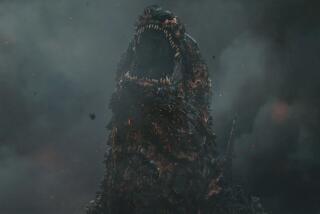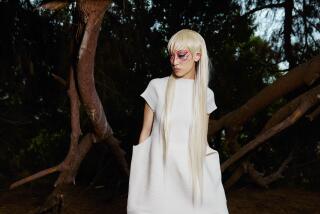Humanity, puppets and scars of war
Fifty years ago, the so-called Hiroshima Maidens, a group of young Japanese women gravely disfigured by the atomic bomb, arrived in New York City for reconstructive surgery. Their sociopolitical saga, rending in its historical context and application to current events, contributes mutely but vividly to the psychic and kinetic fallout from “Hiroshima Maiden” at REDCAT.
By approaching this sorrowful tale from a distinctly acerbic personal viewpoint, puppet theater master Dan Hurlin addresses America’s tunnel vision about its global legacy, while he and a selfless company express its still-emerging impact in delicately brilliant terms.
During the U.S. occupation, the families of hibakusha (survivors) kept their maimed out of sight. Buddhist and Shinto beliefs viewed the keloid scarring of these young women as proof of ancestral trespasses. In the U.S., a State Department intent on the Cold War banned images of atomic survivors from the media (a blackout that held until 1964). U.S. schoolchildren prepared for nuclear attack by crawling under desks and closing their eyes.
In 1951, Kiyoshi Tanimoto, a Japanese Methodist minister, contacted Saturday Review editor Norman Cousins about the situation. By 1955, 25 girls for whom reconstructive surgery seemed most beneficial flew to Manhattan. There, a crew of surgeons performed more than 140 operations on the group, eventually known as the Hiroshima Maidens. Their appearance on Ralph Edwards’ “This Is Your Life,” which Hurlin caught as a channel-switching child, proved historic.
That televised catharsis, slightly tweaked, is the final destination of Hurlin’s nonlinear, autobiographical focus. Using the Japanese bunraku tradition as a template, Hurlin turns input from historian David Serlin and peace activist Michiko Yamaoka (one of the hibakusha), into a coolly magical dreamscape.
Acting as the traditional tayu (narrator), Hurlin sits beside the stage, musing on “the young American boy.” Beside him is indispensable composer Robert Een, an Obie winner for his marvelous, jazz-flavored score. Approximating the Japanese shamisen on his cello, Een melds with the prerecorded instrumental and vocal contributions of Jeff Berman and Bill Ruyle.
They accompany nine fantastic functionaries in black, who freely control the panels, miniature settings and detailed props of Hurlin’s concept. Silhouettes, window boxes and forced perspectives dance to hypnotic effect, aided by Tyler Micoleau’s nuanced lights and Julie Alane Simons’ shrewd slides. Photographic flashes and fragmenting faces become ominous themes. A tiny kimono (one of many by costumer Anna Thomford) turns a puppeteer’s arm into one of a line of geishas, their egg-shaped heads gradually replaced by shattered versions.
The principal puppets are extraordinary throughout, from red-clad heroine to government official to Enola Gay pilot. Such gracefully negotiated eloquence lingers well after the lights come up on this enthralling, sobering shadow play.
*
‘Hiroshima Maiden’
Where: REDCAT at Walt Disney Concert Hall, 631 W. 2nd St., L.A.
When: 8:30 tonight, 3 p.m. Sunday
Ends: Sunday
Price: $28 and $32
Contact: (213) 237-2800 or www.redcat.org
Running time: 1 hour, 30 minutes
More to Read
The biggest entertainment stories
Get our big stories about Hollywood, film, television, music, arts, culture and more right in your inbox as soon as they publish.
You may occasionally receive promotional content from the Los Angeles Times.










